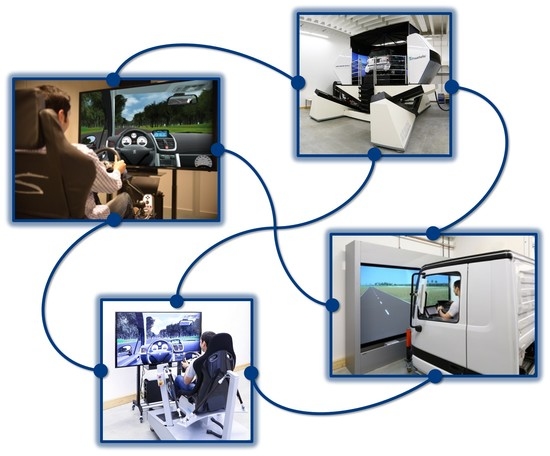Networked Driving Simulation: Applications, State of the Art, and Design Considerations
Abstract
:1. Introduction
2. Potential Applications of Networked Driving Simulation
2.1. Networked Driving Simulation for Research and Development
2.1.1. Engineering Research and Development
2.1.2. Psychology Research
2.1.3. Medicine Research
2.2. Networked Driving Simulation for Training Purposes
3. Problem Description and System Requirements
- Systematic approachThe design of networked driving simulation shall follow a systematic approach. This systematic approach shall help developers to determine the necessary fidelity levels and capabilities of the constituent systems, and hence, the complexity of the overall system.
- Open system interfaceThe platforms of networked driving simulation shall conform to the open interface principle. This results in open systems that have permeable boundaries. Consequently, the exchange of information with constituent systems eventually added in future shall be allowed through a straightforward integration process. This requirement can be realized by the utilization of standard interfacing or networking techniques, such as High-Level Architecture and Distributed Interactive Simulation [19,20].
- Configurability principleThe platforms of networked driving simulation shall ensure a good extent of configurability to sustain themselves against eventual changes in requirements. This feature can be realized, for instance, through the utilization of configurable constituent systems.
- Modularity principleThe platforms of networked driving simulation shall have a good extent of modularity. This means that each constituent system shall perform a major specific task or function independently. Constituent systems performing more than one task or function are not preferred due to associated complexity of system adaptation.
4. State of the Art Review and Analysis
4.1. Networked Driving Simulation in Literature
4.2. Existing Platforms of Networked Driving Simulation
4.2.1. Multi-Driver Simulation Lab at DLR
Technical Description
Application Scope
4.2.2. Tokyo Virtual Living Simulation Lab at NII
Technical Description
Application Scope
4.2.3. Driving and Bicycling Simulation Lab at OSU
Technical Description
Application Scope
5. Evaluation and Discussion
6. Conclusions and Future Work
Acknowledgments
Author Contributions
Conflicts of Interest
References
- Abdelgawad, K.; Abdelkarim, M.; Hassan, B.; Grafe, M.; Gräßler, I. A Modular Architecture of a PC-Based Driving Simulator for Advanced Driver Assistance Systems Development. In Proceedings of the 15th IEEE International Workshop on Research and Education in Mechatronics (REM2014), El Gouna, Egypt, 9–11 September 2014; ISBN 978-1-4799-3030-2. [Google Scholar]
- Fisher, D.; Caird, J.; Rizzo, M.; Lee, J. Handbook of Driving Simulation for Engineering, Medicine, and Psychology; CRC Press Taylor & Francis Group: Boca Raton, FL, USA, 2011; pp. 1-1–1-16. ISBN 978-1-4200-6100-0. [Google Scholar]
- Quandt, T.; Kröger, S. Multiplayer: The Social Aspects of Digital Gaming, 1st ed.; Routledge, Taylor & Francis Group: Abingdon, UK, 2014; pp. 3–9. ISBN 978-0-415-82885-7. [Google Scholar]
- Abdelgawad, K.; Hassan, B.; Berssenbrügge, J.; Stöcklein, J.; Grafe, M. A Modular Architecture of an Interactive Simulation and Training Environment for Advanced Driver Assistance Systems. Int. J. Adv. Softw. IARIA 2015, 8, 247–261. [Google Scholar]
- Wolshon, B.; Pande, A. Traffic Engineering Handbook: Institute of Transportation Engineers, 7th ed.; Wiley & Sons: Hoboken, NY, USA, 2016; pp. 217–225. ISBN 978-1-118-76230-1. [Google Scholar]
- Chraibi, M.; Boltes, M.; Schadschneider, A.; Seyfried, A. Traffic and Granular Flow ’13, 1st ed.; Springer: Cham, Switzerland, 2015; pp. 533–539. ISBN 978-3-319-10628-1. [Google Scholar]
- Watzenig, D.; Horn, M. Automated Driving: Safer and More Efficient Future Driving, 1st ed.; Springer: Cham, Switzerland, 2017; pp. 29–40. ISBN 978-3-319-31893-6. [Google Scholar]
- Yamaguchi, M.; Wakasugi, J.; Sakakima, J. Evaluation of Driver Stress Using Biomarker in Motor-Vehicle Driving Simulator. In Proceedings of the 28th Annual International Conference on Medicine and Biology Society (EMBS), New York, NY, USA, 16–19 September 2006; pp. 1834–1837, ISSN:1557-170X. [Google Scholar]
- Farmer, E.; van Rooij, J.; Riemersma, J.; Jorna, P. Handbook of Simulator-Based Training, 1st ed.; Routledge, Taylor & Francis Group: Abingdon, UK, 1999; ISBN 978-0754611875. [Google Scholar]
- Kandhai, K.; Smith, M.; Kanneh, A. Immersive Driving Simulation for Driver Education and Analysis. In Proceedings of the 16th International Conference on Computer Games (CGAMES), Louisville, KY, USA, 27–30 July 2011; ISBN 978-1-4577-1451-1. [Google Scholar]
- Imamura, T.; Ogi, T.; Lun, E.T.C.; Zhang, Z.; Miyake, T. Trial Study of Traffic Safety Education for High School Students Using Driving Simulator. In Proceedings of the IEEE International Conference on Systems, Man, and Cybernetics (SMC), Manchester, UK, 13–16 October 2013; ISBN 978-1-4799-0650-5. [Google Scholar]
- Ogitsu, T.; Mizoguchi, H. A Study on Driver Training on Advanced Driver Assistance Systems by Using a Driving Simulator. In Proceedings of the International Conference on Connected Vehicles and Expo (ICCVE), Shenzhen, China, 19–23 October 2015; ISBN 978-1-5090-0264-1. [Google Scholar]
- Panou, M.C.; Bekiaris, E.D.; Touliou, A.A. ADAS Module in Driving Simulation for Training Young Drivers. In Proceedings of the 13th International IEEE Conference on Intelligent Transportation Systems (ITSC), Funchal, Portugal, 19–22 September 2010; ISBN 2153-0009. [Google Scholar]
- Maag, C.; Muhlbacher, D.; Mark, C.; Kruger, H.P. Studying Effects of Advanced Driver Assistance Systems (ADAS) on Individual and Group Level Using Multi-Driver Simulation. IEEE Intell. Transp. Syst. Mag. 2012, 4, 45–54. [Google Scholar] [CrossRef]
- Beasley, H.H.; Harding, T.H.; Martin, J.S.; Rash, C.E. Laboratory system for the evaluation of helmet-mounted displays. In Proceedings of the SPIE, the International Society for Optical Engineering, Orlando, FL, USA, 12–13 September 2004; Volume 5442, ISBN 9780819453655. [Google Scholar]
- Dumitrescu, R.; Anacker, H.; Gausemeier, J. Design Framework for the Integration of Cognitive Functions into Intelligent Technical Systems. In Proceedings of the 1st Joint International Symposium on System-Integrated Intelligence, Hannover, Germany, 27–29 June 2012. ISSN:0944-6524. [Google Scholar]
- Dumitrescu, R.; Jürgenhake, C.; Gausemeier, J. Intelligent Technical Systems OstWestfalenLippe. In Proceedings of the 1st Joint International Symposium on System-integrated Intelligence, Hannover, Germany, 27–29 June 2012. ISSN:0944-6524. [Google Scholar]
- DiMario, M.J. System of Systems Collaborative Formation, 1st ed.; World Scientific Publishing: Singapore, 2010; pp. 29–62. ISBN 978-981-4313-88-9. [Google Scholar]
- Wang, W.; Xu, Y.; Chen, X.; Li, Q.; Wang, W. High level architecture evolved modular federation object model. J. Syst. Eng. Electron. 2009, 20, 625–635. [Google Scholar]
- Xu, C.; Song, J.; Chen, M.; Chen, J.; Yu, L. Research on Adaptive State Update Strategy of Distributed Interactive Simulation. In Proceedings of the 3rd IEEE International Conference on Multimedia Information Networking and Security (MINES), Shanghai, China, 4–6 November 2011; ISBN 978-1-4577-1795-6. [Google Scholar]
- Cai, H.; Lin, Y.; Cheng, B. Mimicking human driving behaviour for realistic simulation of traffic flow. Int. J. Simul. Process Model. 2010, 6, 126–136. [Google Scholar] [CrossRef]
- Bando, T.; Shibata, T. Networked Driving Simulator Based on SIGVerse and Lane-Change Analysis According to Frequency of Driving. In Proceedings of the 15th International IEEE Conference on Intelligent Transportation Systems (ITSC), Anchorage, AK, USA, 16–19 September 2012; ISBN 978-1-4673-3064-0. [Google Scholar]
- Tan, J.; Inamura, T. What Are Required to Simulate Interaction with Robot? SIGVerse—A Simulation Platform for Human-Robot Interaction. In Proceedings of the International IEEE Conference on Robotics and Biomimetics (ROBIO), Phuket, Thailand, 7–11 December 2011; ISBN 978-1-4577-2136-6. [Google Scholar]
- Heesen, M.; Baumann, M.; Kelsch, J.; Nause, D.; Friedrich, M. Investigation of Cooperative Driving Behaviour during Lane Change in a Multi-Driver Simulation Environment. In Proceedings of the Human Factors and Ergonomics Society (HFES) Europe Chapter Conference, Toulouse, France, 10–12 October 2012; ISBN 978-0-945289-44-9. [Google Scholar]
- Yasar, H.; Berbers, Y.; Preuveneers, D. A Computational Analysis of Driving Variations on Distributed Multiuser Driving Simulators. In Proceedings of the IASTED International Conference on Modelling and Simulation, Quebec, QC, Canada, 26–28 May 2008; pp. 178–186, ISBN 978-0-88986-764-2. [Google Scholar]
- Hancock, P.; Ridder, S. Behavioural accident avoidance science: Understanding response in collision incipient conditions. Ergon. J. 2003, 46, 1111–1135. [Google Scholar] [CrossRef] [PubMed]
- Houtenbos, M. Expecting the Unexpected: A Study of Interactive Driving Behaviour at Intersections. Ph.D. Thesis, TU Delft, TRAIL Research School, Delft, The Netherlands, 2008. [Google Scholar]
- Rittger, L.; Mühlbacher, D.; Maag, C.; Kiesel, A. Anger and Bother Experience When Driving with a Traffic Light Assistant: A Multi-Driver Simulator Study. In Proceedings of the Annual Conference of Human Factors and Ergonomics Society Europe Chapter, Lisbon, Portugal, 8 October 2014; pp. 41–45. [Google Scholar]
- Sawyer, B.; Hancock, P. Development of a Linked Simulation Network to Evaluate Intelligent Transportation System Vehicle to Vehicle Solutions. In Proceedings of the 56th Annual Meeting of Human Factors and Ergonomics Society, Boston, MA, USA, 22–26 October 2012; ISBN 978-0-945289-41-8. [Google Scholar]
- Ma, T.; Li, T. A multi-driver simulator study Development and application of an integrated traffic simulation and multi-driving simulators. J. Simul. Model. Pract. Theory 2015, 59, 1–17. [Google Scholar]
- Niu, D.; Sun, J. Eco-Driving Versus Green Wave Speed Guidance for Signalized Highway Traffic: A Multi-Vehicle Driving Simulator Study. J. Soc. Behav. Sci. 2013, 96, 1079–1090. [Google Scholar] [CrossRef]
- Li, L.; Cao, J.; Liao, X.; Zhao, A. Research and Implementation of Virtools Based on 3D Virtual Teaching Laboratory. In Proceedings of the 3rd International Conference on Computer Science and Network Technology (ICCSNT), Dalian, China, 12–13 October 2013; ISBN 978-1-4799-0560-7. [Google Scholar]
- Gajananan, K.; Nantes, A.; Miska, M.; Nakasone, A.; Prendinger, H. An Experimental Space for Conducting Controlled Driving Behavior Studies based on a Multiuser Networked 3D Virtual Environment and the Scenario Markup Language. IEEE Trans. Hum.-Mach. Syst. 2013, 29, 345–358. [Google Scholar] [CrossRef]
- Oeltze, K.; Schießl, C. Benefits and challenges of multi-driver simulator studies. IEEE J. IET Intell. Transp. Syst. 2015, 9, 618–625. [Google Scholar] [CrossRef]
- Lorenz, T.; Baumann, M.; Jaschke, K.; Koster, F. A Modular and Scalable Application Platform for Testing and Evaluating Its Components. In Proceedings of the 20th IEEE International Workshops on Enabling Technologies: Infrastructure for Collaborative Enterprises (WETICE), Paris, France, 27–29 June 2011; ISBN 978-1-4577-0134-4. [Google Scholar]
- Laschinsky, J.; von Neumann-Cosel, K.; Gonter, M.; Wegwerth, C.; Dubitzky, R.; Knoll, A. Evaluation of an Active Safety Light using Virtual Test Drive within Vehicle in the Loop. In Proceedings of the IEEE International Conference on Industrial Technology (ICIT), Vi a del Mar, Chile, 14–17 March 2010; ISBN 978-1-4244-5695-6. [Google Scholar]
- Prendinger, H.; Gajananan, K.; Zaki, A.; Fares, A.; Molenaar, R.; Zaki, A.; Urbano, D.; Lint, H.; Gomaa, W. Tokyo Virtual Living Lab: Designing Smart Cities Based on the 3D Internet. IEEE Int. Comput. Mag. 2013, 17, 30–38. [Google Scholar] [CrossRef]
- Stoianovici, V.; Talaba, D.; Nedelcu, A.; Pisu, M.; Barbuceanu, F.; Stavar, A. A Virtual Reality Based Human-Network Interaction System for 3D Internet Applications. In Proceedings of the 12th IEEE International Conference on Optimization of Electrical and Electronic Equipment (OPTIM), Brasov, Romania, 20–22 May 2010; ISBN 978-1-4244-7019-8. [Google Scholar]
- Bonotti, A.; Genovali, L.; Ricci, L. DiVES: A Distributed Support for Networked Virtual Environments. In Proceedings of the 20th International Conference on Advanced Information Networking and Applications (AINA 2013), Gothenburg, Sweden, 18–20 April 2006; ISBN 0-7695-2466-4. [Google Scholar]
- Nuckelt, J.; Rose, D.; Jansen, T.; Kürner, T. On the Use of OpenStreetMap Data for V2X Channel Modeling in Urban Scenarios. In Proceedings of the 7th European Conference on Antennas and Propagation (EuCAP), Gothenburg, Sweden, 8–12 April 2013; ISBN 978-1-4673-2187-7. [Google Scholar]
- Hu, X.; Liu, X.; He, Z.; Zhang, J. On the use of OpenStreetMap data for V2X channel modeling in urban scenarios. In Proceedings of the IET International Conference on Smart and Sustainable City 2013 (ICSSC 2013), Gothenburg, Sweden, 19–20 August 2013; ISBN 978-1-84919-707-6. [Google Scholar]
- Prendinger, H.; Oliveira, J.; Catarino, J.; Madruga, M.; Prada, R. iCO2—A Networked Game for Collecting Large-Scale Eco-Driving Behavior Data. IEEE Internet Comput. Mag. 2014, 18, 28–35. [Google Scholar] [CrossRef]
- Swake, J.; Jannat, M.; Islam, M.; Hurwitz, D. Driver Response to Phase Termination at Signalized Intersections: Are Driving Simulator Results Valid? In Proceedings of the 7th International Driving Symposium on Human Factors in Driver Assessment, Training, and Vehicle Design, New York, NY, USA, 17–20 June 2013; ISBN 9780615819723. [Google Scholar]
- Warnera, J.; Hurwitza, D.S.; Monsereb, C.M.; Fleskesa, K. A simulator-based analysis of engineering treatments for right-hook bicycle crashes at signalized intersections. J. Accid. Anal. Prev. 2017, 104, 46–57. [Google Scholar] [CrossRef] [PubMed]
- Jamshidi, M. System of Systems Engineering: Innovations for the Twenty-First Century, 1st ed.; John Wiley & Sons: Hoboken, NJ, USA, 2008; pp. 1–20. ISBN 9780470195901. [Google Scholar]
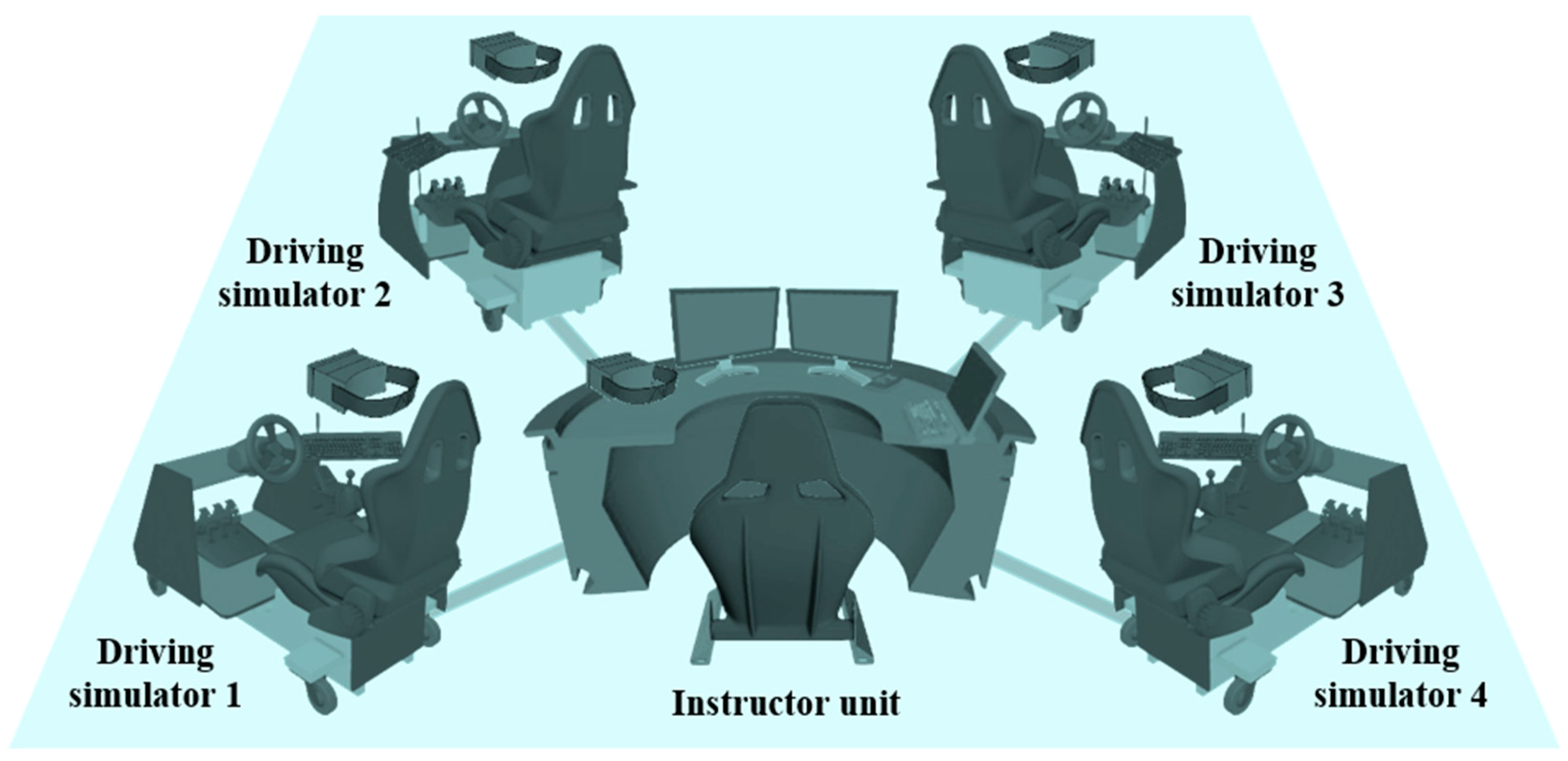
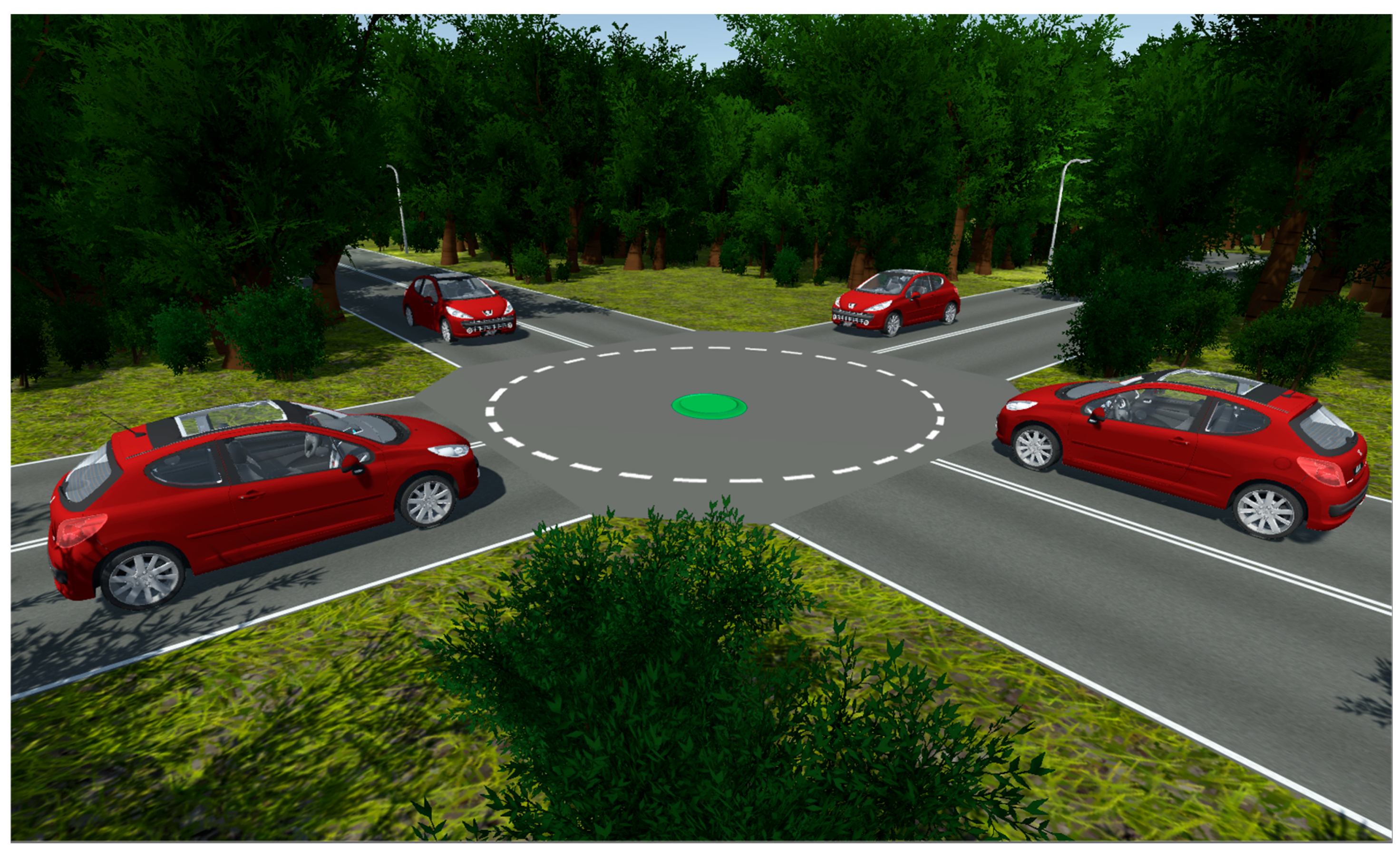

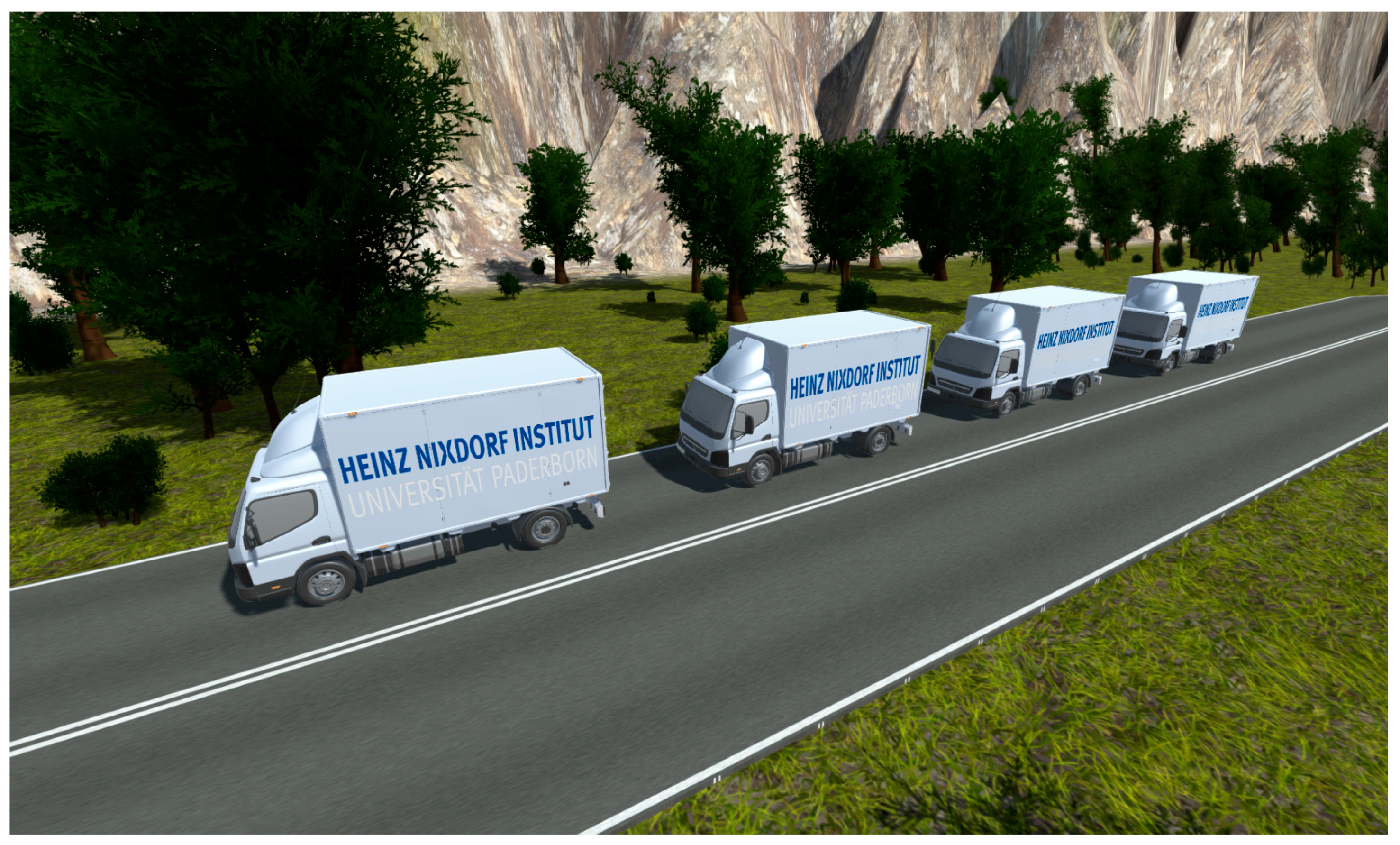

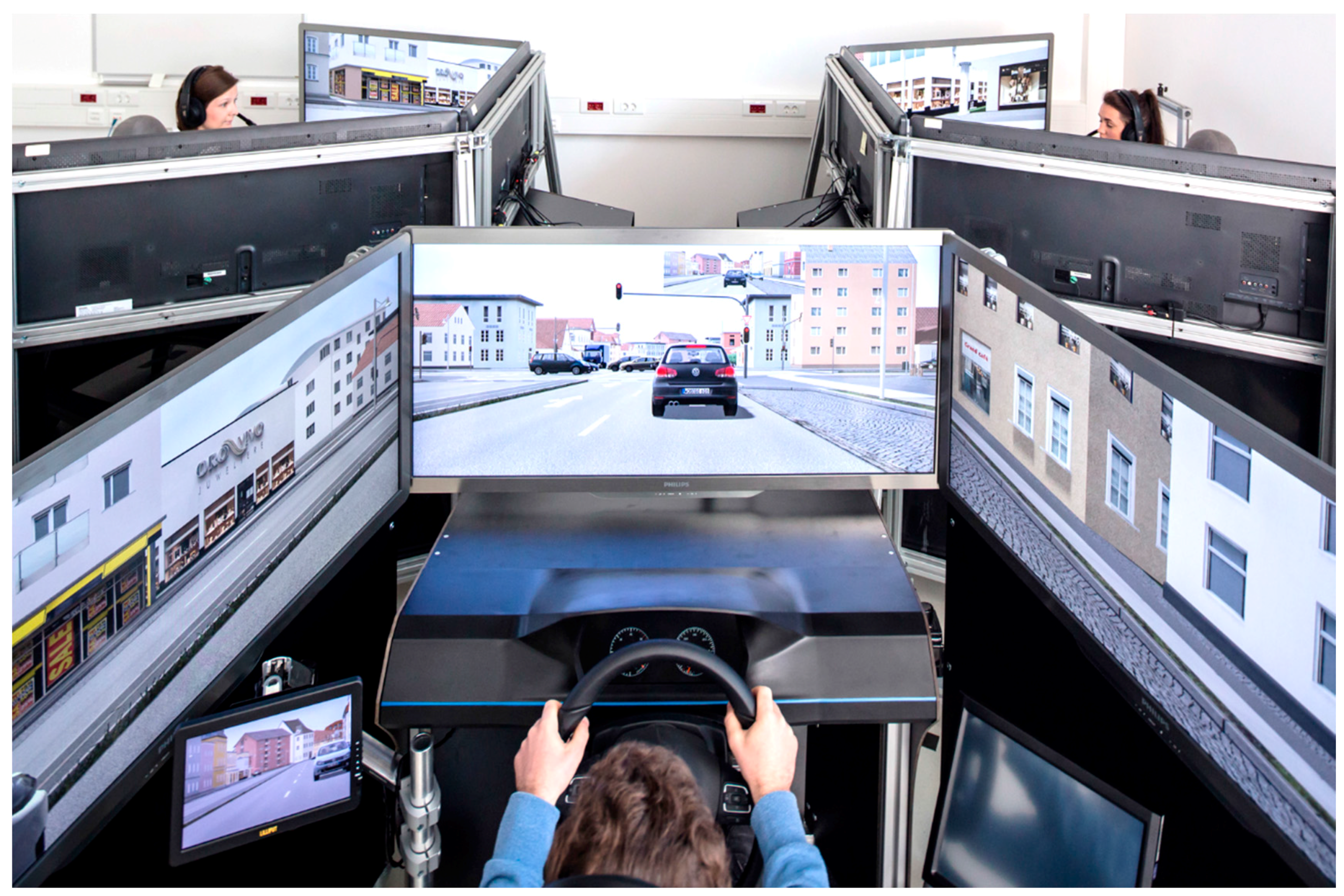

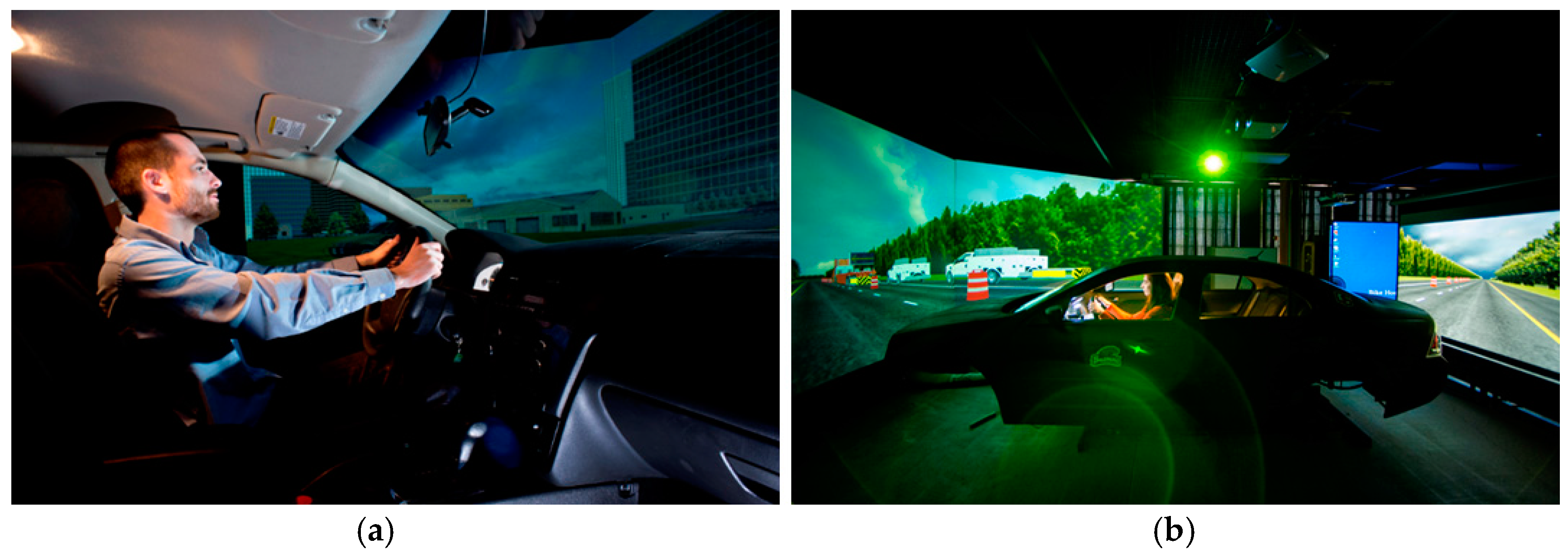
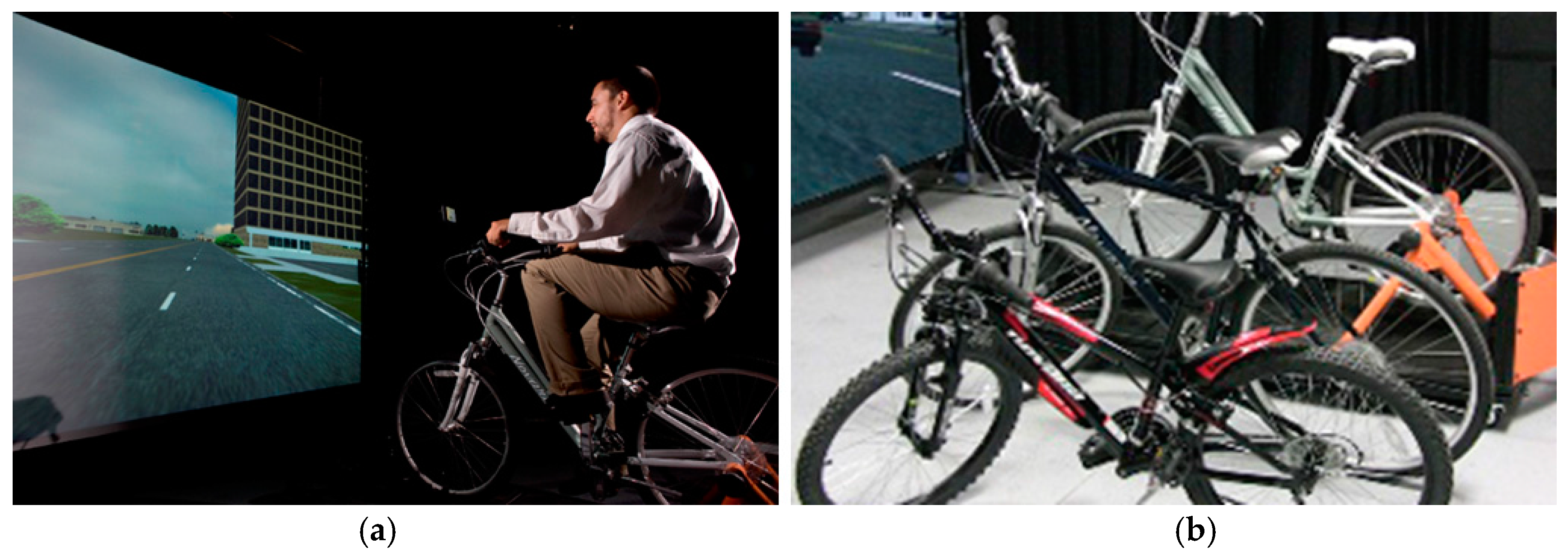
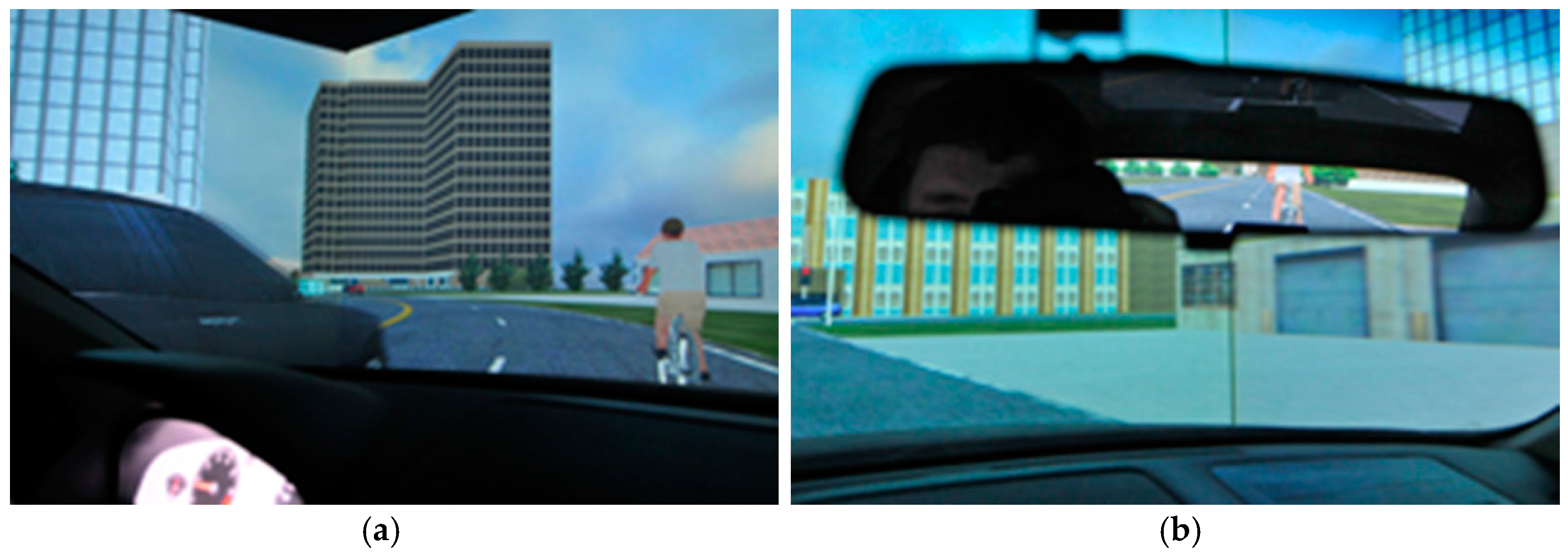
| Evaluation Scheme of the Examined Facilities | Requirements | |||
|---|---|---|---|---|
 = Not Fulfilled = Not Fulfilled | Systematic Approach | Open Interface Principle | Configurability Principle | Modularity Principle |
 = Partially Fulfilled = Partially Fulfilled | ||||
 = Totally Fulfilled = Totally Fulfilled | ||||
| Examined Facilities | R1 | R2 | R3 | R4 |
| Multi-Driver Simulation Lab at DLR |  |  |  |  |
| Tokyo Virtual Living simulation Lab at NII |  |  |  |  |
| Driving and Bicycling Simulation Lab at OSU |  |  |  |  |
© 2017 by the authors. Licensee MDPI, Basel, Switzerland. This article is an open access article distributed under the terms and conditions of the Creative Commons Attribution (CC BY) license (http://creativecommons.org/licenses/by/4.0/).
Share and Cite
Abdelgawad, K.; Gausemeier, J.; Dumitrescu, R.; Grafe, M.; Stöcklein, J.; Berssenbrügge, J. Networked Driving Simulation: Applications, State of the Art, and Design Considerations. Designs 2017, 1, 4. https://doi.org/10.3390/designs1010004
Abdelgawad K, Gausemeier J, Dumitrescu R, Grafe M, Stöcklein J, Berssenbrügge J. Networked Driving Simulation: Applications, State of the Art, and Design Considerations. Designs. 2017; 1(1):4. https://doi.org/10.3390/designs1010004
Chicago/Turabian StyleAbdelgawad, Kareem, Jürgen Gausemeier, Roman Dumitrescu, Michael Grafe, Jörg Stöcklein, and Jan Berssenbrügge. 2017. "Networked Driving Simulation: Applications, State of the Art, and Design Considerations" Designs 1, no. 1: 4. https://doi.org/10.3390/designs1010004




